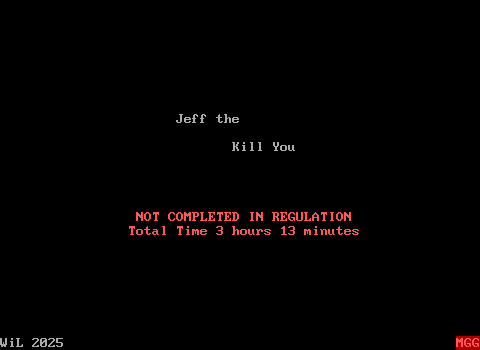Today's article focuses on a rather unusual release by the name of Fabrication. I can't recall what brought this world to my attention, likely clicking around haphazardly while testing things for the Museum. Two facts about the game made me unable to resist looking at the game itself:
- It won a Game of the Month award in February 1999.
- Nothing seems to have ever been written about the game.
The latter describes hundreds and hundreds of ZZT worlds preserved on the Museum. Depending on when a game was released, major archives may or may not have had any review system in place. Those that may have been covered on ZZTer ran websites often vanished in a puff of smoke leaving no traces for the Wayback Machine. The only well-preserved writing about ZZT prior to z2 comes from ZZT magazines which have no good way to find out if a game was covered short of combing through each one.
The former, however, turns it into an outlier. The Game of the Month award meant that your world would be featured on the front page of the ZZT archive/z2 until the next month's winner was determined. These winners would then get a short write-up by staff or prominent community members praising the game. Yet somehow, Fabrication has no proper article. Investigating on the z2 side confirms that the game has no review. It's not even the only one! Chrono Wars 11 is similarly blank. Most bizarre of all, Teen Priest 2, one of ZZT's most important releases somehow never got covered either.
Chrono Wars, as a huge series has at least been noticed in user reviews for other games in the series, and was featured in a Worlds of ZZT stream back in 2021. Teen Priest 2 has a handful of reviews written a few years after its release discussing how it compares to the original. Both these games are pretty notable titles, where the lack of a review is a surprise, but for those around in 1999 these are some of the most iconic games of the era.
I don't know what Fabrication is. Or at least I didn't. Even the game's text file provided no insight, only providing an email address to reach the author at to report any bugs found in the demo.
That's another weird thing! The Game of the Month award was to be handed out to the best world published in a given month. Demos really have an uphill battle as by definition they are an incomplete experience. Demos winning the award means that the competition was either so dire that it was still the best choice, or that the demo's yet-to-be-fulfilled promises are being taken as fact. Not only did I want to see for myself what Fabrication's whole deal was, but I also wanted to get an idea of what other games would have been released around the same time.
The Challengers
The specifics are undoubtedly blurry. The GotM award restricted itself to games published during a given month[1]. That information is lost to time. Today, the best information available is to use the file's modification date, assuming that games didn't sit around for long before being uploaded. That puts us in the right direction, though you can never be sure how long a game was stuck in the upload queue. This very much becomes relevant when trying to figure out what likely was released around the same time as Fabrication, despite that the sheer number of releases back then meant publishing was happening often multiple times per week.
Fabrication's ZZT file is dated Feb. 17th, 1999. The previous month's winner Buck Russel: Private Eye v2.0 is... from 1998. So we're still dealing with the "anything goes" era there. Perhaps Fabrication was the first game to use the month-specific restriction of eligibility.
On the other end, the next month's GotM winner is Speed Racer X which is dated ...Feb. 14th, 1999, so it won April's award despite being dated earlier than the game that won March's. Cool. Awesome. Great.
So, based on the fact that 1999 has more than 300 releases, I figured I'd just look at those marked January and February and assume any of them could potentially have been published together. Back in the day, publishing worlds was happening pretty regularly, with the queue rarely getting out of hand. (This was before z2 and its enforced quality standards required staff to actually look at every game to ensure compliance with the use of Super Tool Kit colors.) Flipping through those releases, I trimmed it down to games that stood out to me even slightly resulting in the following list of titles:
| Date | Title | Etc. |
|---|---|---|
| Jan. 02 | Infestation: Tower of Babel | Action game where you shoot (mutant) centipedes. I liked this series as a child, though it's probably not something you'd think of as "award-winning". |
| Jan. 05 | Fury Spell | RPG about avenging your wizard mentor after his assassination. Some nice looking boards, and plenty of those RPG battles ZZTers couldn't get enough of at the time. Later won a Classic Game of the Month award. |
| Jan. 06 | George Badluck Demo | If Fabrication could win with a demo, surely Badluck can too. A comedic adventure with some impressive art. Also Scribbit was a name I can recall hearing a decent amount back then. |
| Jan. 08 | Station 202 | Another Scribbit game, a full adventure with muck monsters that have run amok (killed everyone) aboard the station. Lets you die by taking off in a space ship before opening the hangar doors, so I assume it's good, though I've never played it. |
| Jan. 23 | Zem! 2 | Sequel to an enjoyable Lemmings inspired game. Issue commands to Zem! to guide him safely to the exit. Solid game that was successful enough that a level pack of contributions by other ZZTers was created. |
| Feb. 11 | PPDV | Viovis's famous trippy experimental art world, which is either brilliant avant-garde material or just scribbling in the editor. I haven't played it. Later won a Classic Game of the Month award though later reviews are highly divisive. |
| Feb. 14 | Speed Racer X | Racing game that won the next month's award, so this isn't actually competition unless both months were still the "anything goes" era for GotM eligibility. |
| Feb. 16 | Da Hood: Special Edition | Remake of one of Tseng's earlier worlds, featuring his gi-normous cast of characters. An author with major cred around 1999/2000 whose every release could potentially be GotM material. |
| Feb. 17 | Fabrication | For reference. |
| Feb. 22 | Corrupt Mind | A journey into the author's broken mind, to fix it. Later won a Classic Game of the Month award, in which Funk praised it. Funk's reviews of ZZT worlds tend to be pretty scathing so if he's impressed.... |
| Feb. 27 | Stupid RPG: Silver Silicon Cartridge Edition! | If you weren't a Tseng fan you may have found yourself partial to Knightt's series loaded with RPG references and a billion characters instead. Depending on the month, Knightt was either beloved or reviled by staff, so this may have had a solid shot or no chance at all of winning a community award. |
To save myself from having to add in a dozen links, you can just flip through two pages of 1999 releases sorted by date. A few others aren't unreasonable to include, though they're often revised releases, which may have just silently replaced older uploads or only been made available on personal/company ZZT websites where file replacement was more commonplace than on community archives.
This list is more of a list of games that elicit a positive response than an accurate sampling. GotM winners never really had to be justified no matter how much complaining there was. Later on the winners would be voted on by the community themselves to "remove bias", eventually causing its share of community drama from some ballot-stuffing to ensure a purposely low-quality world would win.
It's worth stressing that 1999 is a really good year for ZZT. Several of the above did win awards later on, and even for a list intended to be generous, nearly half of them wouldn't surprise me to hear that they had won a Game of the Month award when they came out. On a whim, I checked out April and May of 2002, giving a similar date range to see what would've competed for the final Game of the Month award. From that set, only the winner The Mercenary, Quantum P.'s first entry in his Operation: GAMMA VELORUM series, and the final release of the ZZT Encyclopedia caught my eye at all. I'm not sure if a compilation of tips and tricks would've vibed with the community's perception of the "Game" of the month at the time, and while I'm a fan of OPRGV, the first part is definitely very dry.
So what the hell is contained within Fabrication, a demo with less than a dozen playable boards, that got itself the prestige front-page treatment for a month?
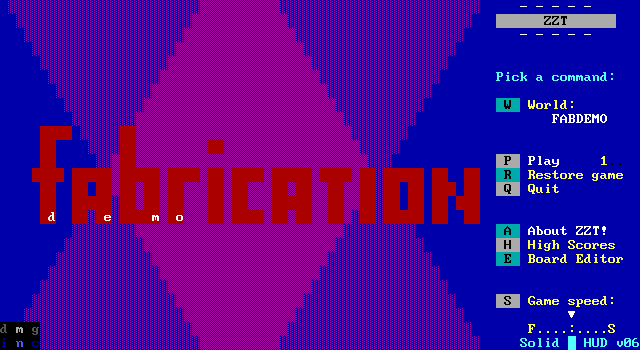
Story
Well, it's not the story that would have earned it any awards.
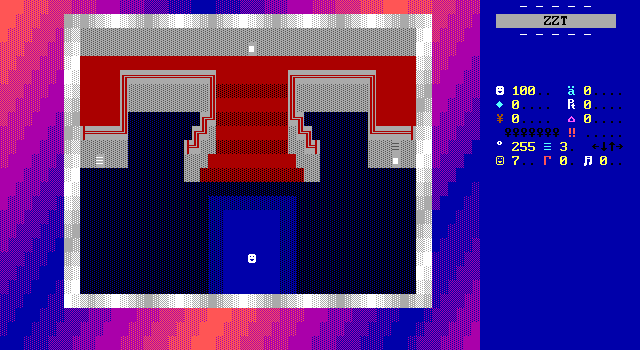
Fabrication opens directly with a gameplay board, opting for the rarely seen in this era Town of ZZT style information object dropped into the middle of the board. This opening scroll covers everything you'd typically expect from a game of this era to include either on a starting menu board, or through passages accessed from a menu. A brief synopsis for the game, the story-line, how battles work, "the bodycount engine", an inventory system, rpg battles, and a brief list of tips.
you are chris adon. you have noticed
something eerie about the town lately.
people have been disappearing, and screams
are heard in the middle of the night,
every night. the cops have done nothing,
for some strange reason. one day you are
walking in the woods when you find one
of your friends lying against a tree in
a bloody mess. in his dying words he says
something about the old procter mansion.
you decide to come and check out the
mansion, armed with a hunter's knife. you
are prepared to kill whatever the hell
is fucking with your town.
• • • • • • • • •
The story is the typical quick and dirty setup for an action game with horror influences. Strange things have been happening in town, the boys in blue are being bastards about it, and it soon becomes personal when Chris Adon discovers a dying friend in the woods one day, providing his motivation to be the one to set things right again. In less typical fashion, Chris's load-out consists only of a knife and not a gun so players will have to get up close to any zombies or other monsters in order to dispatch them.
There is of course more to it than that. Taking cues from Resident Evil in particular, once Chris not-Redfield enters the mansion, he can begin to not only deal with the monsters that have been feeding on the innocent populace, but to find those all important files left lying around the place. Chris offers no comment on anything he comes across, leaving up to players to connect the obvious dots.
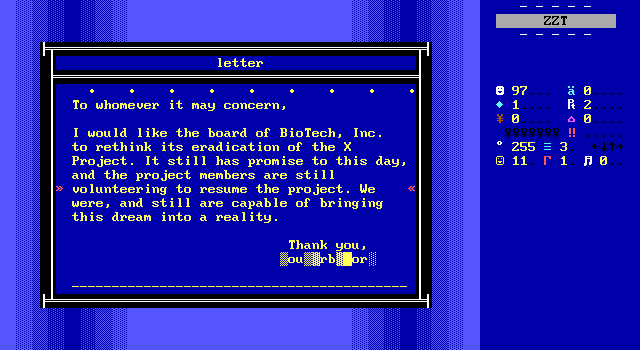
While it took until 2001 for ZZT to get a game that was explicitly a Resident Evil fan game, the series clearly had an impact on the types of ZZT action titles produced for several years prior. It seems that everywhere you looked there were biological experiments running amok. Fabrication is no different with its mansion setting and unscrupulous BioTech corporation. Although the serial numbers may have been filed off, breakout isn't trying to hide where the game's concept came from, with that same opening scroll describing the game as "a weird resident evil type game".
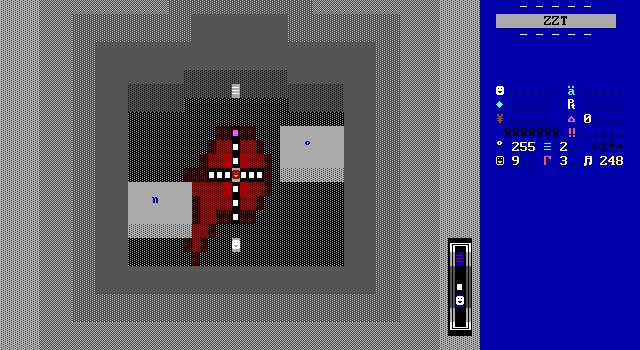
Given the short length of the demo, there's not a whole lot of room for the story to go anywhere. The file helps establish where these monsters are coming from, putting the game in the "man meddles in things they shouldn't have" as opposed to your pick of supernatural entities that crave human flesh or a perfectly natural viral outbreak with serious implications for humanity. There's nothing else for players to learn until the last scene of the game where a dying scientist spills the beans on BioTech. The company restarted a once-canceled project that alters nature in "ways it was never meant to be". Chris asks for some more details, but the scientist is abruptly killed off by a cross of energy (boulders of flashing colors) from nowhere. Before the scientist can be killed he gets out most of a name "Tuokaerb Yo-".
Oh heck, I've once again failed the first test of any made up name for something in ZZT. You have to try reading it backwards. The file early on provides one extra letter so it looks like it's "?roy Breakout". Man. I really hope that's just Breakout being cheeky with his villain name and not a surprise self-insert where the author is responsible for all the trouble. I suppose we'll never know.
Gameplay
I certainly don't feel like breakout is trying to win players over with the game's story. In fact, for me at least, the story is my biggest complaint about the game. We've all doubtlessly seen our share of unethical biological experiments really making a mess out of things. In 1999 at least, the concept was still a bit fresher. Again, just being a demo helps here. It's a lot easier to give breakout the benefit of the doubt and hold out hope that the full game's story might go somewhere a little more interesting.
That's not the case with what we actually get to see. What breakout seems to want to give players is what a game where Chris takes on the role of the action movie protagonist, taking down anything that gets in his way no matter how scary it may be. There's no better evidence for the interpretation than in the "bodycount engine" that lies at the heart of the game to encourage players to truly kill everything that can be killed.
One challenge action developers run into with ZZT is how to make players actually care to fight the enemies rather than run away. This can be done with some finesse by designing boards that work with enemy capabilities. This is the philosophy ol' Tim Sweeney favored. By breaking up boards into smaller chunks, and making liberal use of keys and doors, players can be forced to enter the fray in order to be able to move on to the next screen.
Dungeons of ZZT in particular is loaded with boards that highlight the abilities of built-in creatures and rarely give players a chance to get through without shooting everything that moves. The Kennel is a fine example[2], as is The Four Stages for outright requiring every creature to be destroyed, Whirlpool for restricting how players can move through a board laden with duplicators to ensure new enemies repopulate the room with every lap, and of course Way Below relies on sheer numbers, dumping 250 ammo on the player and telling them to reach the end.
Give a player a big room with few enemies, or enemies that don't rush at the player, and they'll probably just go around. Maybe if the ammo is really plentiful they'll take pot-shots from a distance. By this point in time, ZZT action game developers had become their own worst enemy. Realism was king and creatures were for newbies that didn't know how to write ZZT-OOP. Far too many action-focused titles of the late 90s/early 2000s run into the same set of issues time and time again. Object-based enemies shoot each other far faster than they shoot players. In the name of "realism" rooms had to look like actual spaces rather than be tailored to the gameplay. According to ZZTers, everything is a rectangle and there are probably plants in every corner, and perhaps more next to any door frames.
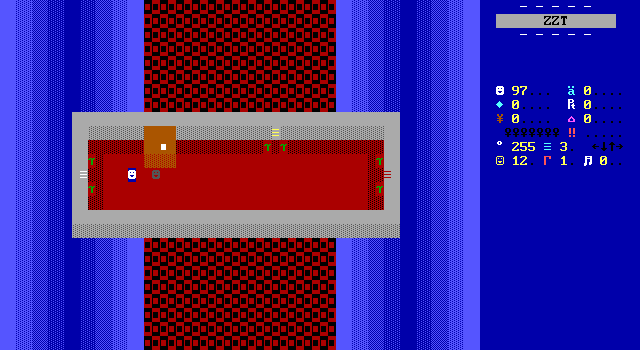
Fabrication falls prey to designing architecture instead of designing levels, with none of the mansion's handful of presented rooms offering anything close to the more complex shapes of the many halls found in Resident Evil. It gets worse once the enemies are added to the mix. No board contains more than two enemies, and while the rooms thankfully aren't the size of an entire ZZT board, players are given plenty of time to observe enemies rather than be startled by them.
Even so, breakout does some nice work at finding ways to make the limited action pan out in the end. Giving the player a knife instead of a gun means that even though enemies are slow moving zombies, they'll cross paths with Chris (Chris-cross?) eventually. The enemies vary in appearance, though behave roughly identically, moving almost exclusively in the player's direction, but critically pausing for a moment after each pair of steps. This eliminates the need to guess when it's safe to go on the offensive, making the combat reward having a little bit of patience rather than just clumsily trading blows with one another. It's quite rare for ZZT games that rely on melee combat to not slowly bleed out players. No health is provided beyond the starting 100, but it's plenty given the enemies you fight and how you fight them.
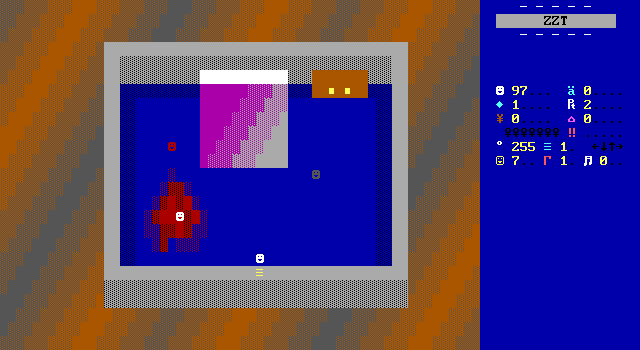
The "engine" isn't really an engine to speak of, but it is a way to entice players. Every enemy killed gives the player a single gem, not as currency or experience, but as a promise for later that the number of enemies killed will have an impact on what ending you get the for the game. Here in the demo, the only thing the gems are used for is to praise or chastise players for how well they did. Something like this could be an effective hook to get players to go after more out of the way enemies or deal with more dangerous foes that they'd prefer to run from. Of course, that all hinges on the idea that the story will compel players enough to want to do so rather than just shrug and open the editor after completing the game. There's promise showing here, even if the bodycount engine could probably use a little refinement.

Gore is another strong aspect of Fabrication's action. All the game's violence is handled via graphics and not text, so there are now gruesome descriptions here. Instead, there are plenty of ZZT's iconic red fakes. Most of these spawn from defeated enemies. Some are already in place as various victims like Chris's friend can be found. Save for the one living scientist at the end, the rest are long dead, with only the body of a teen-aged girl being able to be investigated with the others remaining non-interactable.
When enemies are killed they erupt in a more dynamic shower of gore. (AKA the object turns into a red slime that spreads while another object turns its breakables into fake walls.) This effect needs to be delicately timed. Erase the slimes too quickly, and there's hardly any difference from saving the author the trouble and just having the enemy turn into a fake wall to begin with. Erase them too slowly, and the tone shifts into that of a parody of violent ZZT games. as entire rooms run red.

Breakout nails it. Perhaps its the open spaces of the game compared to the more cramped dungeon crawlers I'm used to seeing such an effect in, but I found it rewarding to see that blood gushing out after a successful kill.
As rarely as ZZT combat is done well, what little is here is surprisingly appealing. Though the enemies are few, Chris's ability to slip-in, stab, slip-out, and repeat until nothing but red fakes remain is admittedly a satisfying gameplay loop. Slow enemies, easy to attack without being struck back, encouragement to clear rooms via promises of a better ending and the immediate reward of seeing enemies explode into a pool of blood all add up to make the simple melee action fun to engage with.
Looking through the game's code, there may have been some other plan for handling the action. A few enemies are programmed to change the color of boulders when they're killed. I can't begin to guess why. Most of the boards in the game don't have any boulders on them, but the one that did occurred early enough that I thought Breakout had a clever idea implemented. On one board, there are boulders in the background which will end up changing from red to blue when an enemy is killed. I thought this was a visual indicator for players to quickly read whether or not a board had been pacified yet. Sadly this wasn't the case.
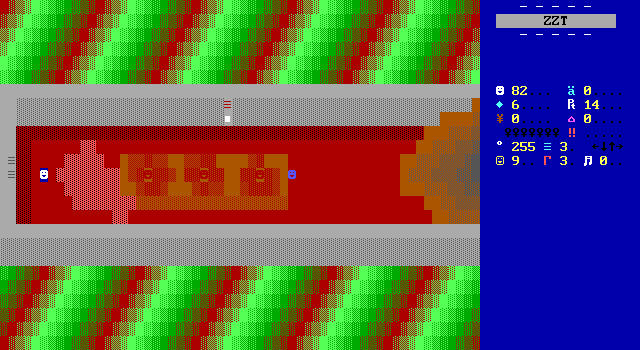
The backgrounds are already nice to have just to break up the usual drab scenery. Turning them into a status indicator to let players know if they could relax on a given screen is a mechanic I don't believe I've seen before. Instead, it seems like it was merely a fluke, creating a missed opportunity.
Misunderstanding the details of the game is a recurring theme. Somehow everything I was wrong about during play wound up not mattering. Likely because as a demo most of what Fabrication does only occurs once.
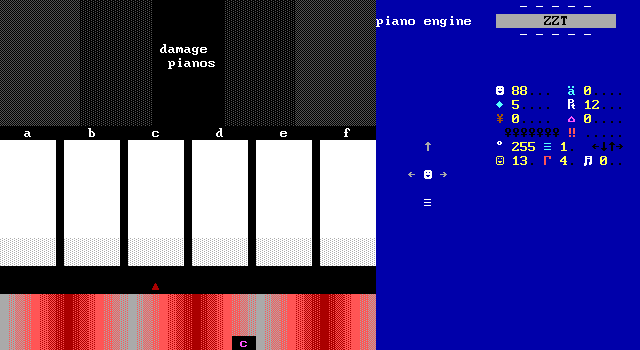
Early on Chris can find a piano and sit down and play. Another clear throwback to the original Resident Evil, there's the expectation that playing something on the piano will cause something to happen.
Unlike Resident Evil where the entire sequence is scripted, players are given control of the world's worst pianist directly, taken to a dedicated piano engine board where a cursor can slowly move between keys and each note on the scale played. With no clues for the puzzle found, I tapped a few keys and left. Little did I know that I had in fact solved the puzzle, and could have done so without playing a single note. For whatever reason, a door in the lobby opens when it detects a flag set for playing the piano. To set this flag, players only need to spend a second or two on the board. The object that sets it does so on a timer which isn't impacted by anything else.
I assume this is just an incomplete puzzle for the demo that hasn't been set up properly yet, but then again, this seems like something that should be implemented fully even for the demo to give players something unique to do. As a fake puzzle, it could raise doubts about Breakout's programming abilities here. After all, pressing a few notes in the correct order is a puzzle so old that you can find it in Town. There seems to be some pride in the board even as it currently stands with its "Damage Pianos" branding, referencing the ZZT company the game was published under.
But if it was the piano puzzle that opened the door, and I didn't think I solved the piano puzzle, what did I think happened to open the door?
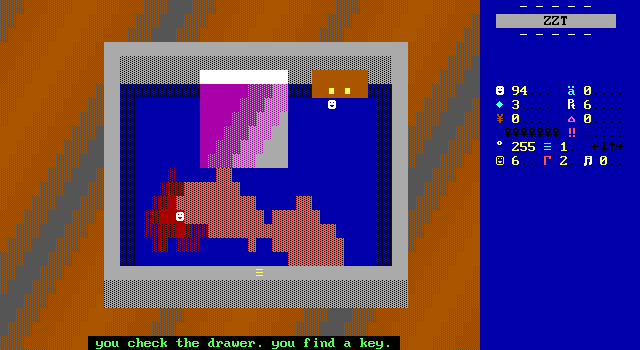
Once again, I found myself praising Breakout for a game mechanic that didn't exist. Before returning to the lobby in a different room I found a key in a drawer and simply assumed it to be for the locked room in the lobby. When I finally returned to the start and saw the previously locked door vanish without having to touch it myself, I thought Breakout had implemented a system where the doors to rooms automatically open once the key is detected rather than only doing so when touched. If the game was going to continue to draw from Resident Evil, this would be a nice way of streamlining the experience of dealing with having some, but not every key and having to check each and every door to discover which uses which key.
In reality, the key was for a locked door deeper in the mansion that I didn't realize was a locked door at all while playing.
And for a mansion, the whole experience is rather small. Once again, being a demo explains the actual lack of size. What's harder to justify is the lack of perceived size. I feel like there should be numerous locked doors, regardless of whether or not they would have been filled out for the full release. Upon finishing the demo, I had no sense that I saw a mere fraction of the mansion. Only one door in the game can't be opened, with the only other obstruction that keeps players from exploring being what I can only guess is some sort of giant boulder blocking off a hallway? It's certainly strange.
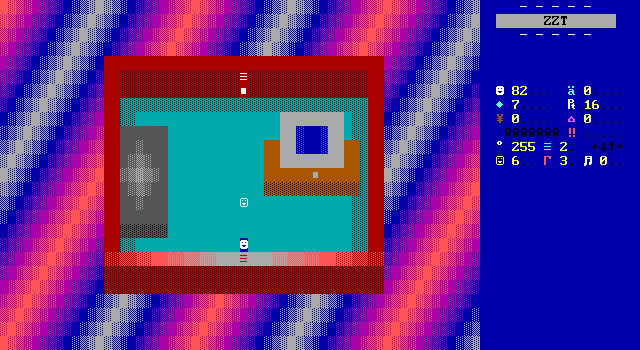
Towards the end the mansion setting gives way to a laboratory. Maybe this is meant to be a "level two" or maybe it's just another room of many in the full mansion. At the very least, this limited section of the game does give some last minute new additions to the game that come as welcome surprises.
The giant computer is comically over-sized, and I couldn't wait to play with it. It may also genuinely be the least helpful computer ever implemented in ZZT!
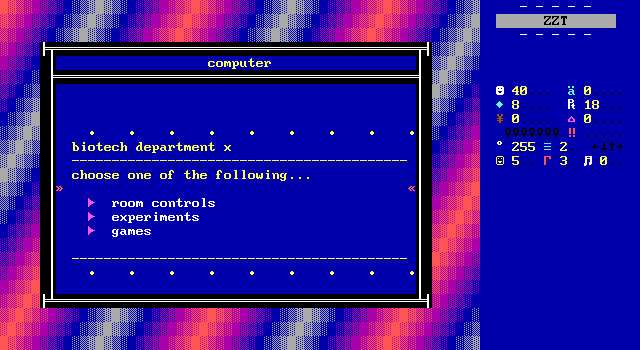
As you'd expect, touching the computer brings up menu with a few options to select. Room controls will be helpful for opening the locked door in the back. Experiments can provide some much needed information on what BioTech is up to. And of course games, because nobody can resist the chance to put ZZT in ZZT. Sounds great.
Instead, players can be denied permission to mess with the lights or cage. (Is that what the thing on the left is supposed to be?) Attempting to open the door causes it to malfunction and remain closed. The experiment information is password protected with Chris refusing to guess. Selecting games just adds insult to injury:
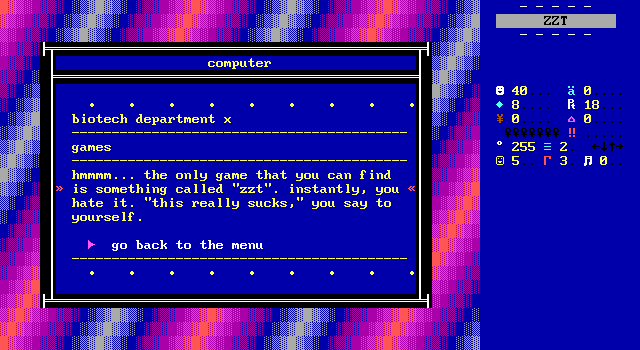
Actually, the ZZT text made me laugh out loud with how unexpected it was. Fabrication doesn't try to be funny, but this goof alone landed better than games I've played that billed themselves as comedies.
Oh. Also this room has a skeleton trying to kill you. That's its last surprise.
It's the only non-zombie enemy, and while it's possible to learn that it's a skeleton from repeated attempts to escape the room without using the computer, more than likely players will treat it like any other zombie at first. No special attention is drawn to its uniqueness, and while I'm not about to pretend I wouldn't have a lot of questions if I saw a zombie, an animated skeleton raises quite a few more. Chris makes no comment about anything he sees while in Procter mansion.
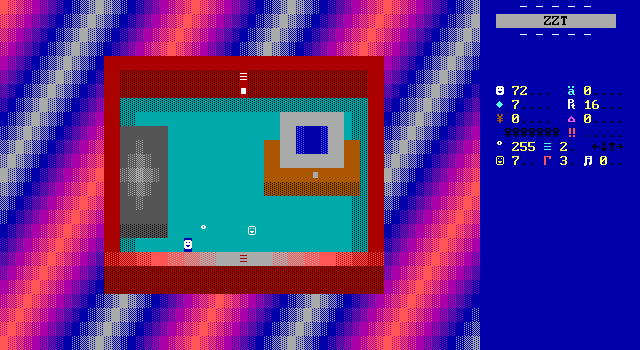
The skeleton ends up standing out instead by breaking the previously established norms. Namely that it can shoot the player! It moves faster than the zombies (though still slower than the player) and has no exploitable idle moment for players to attack. Instead you need to just go in and give it all you've got. This isn't all that difficult. Three hits just as with the other foes before it crumbles to nothing.
At the time, I wondered why it didn't bleed out like everything else. Good job Breakout, I feel like a lot games that copy/paste and tweak enemies would have mistakenly left the blood in. Your realism is duly noted.
Weirdly enough, the door can be opened manually after players attempt to do so with the computer. Despite being the closest thing the game has to a boss fight, the skeleton can be avoided entirely if you know what you're doing. More likely though, players will assume the door either requires the skeleton to be defeated first or can't be opened at all. Another easy way for players to come up with an incorrect assumption for how Fabrication works.
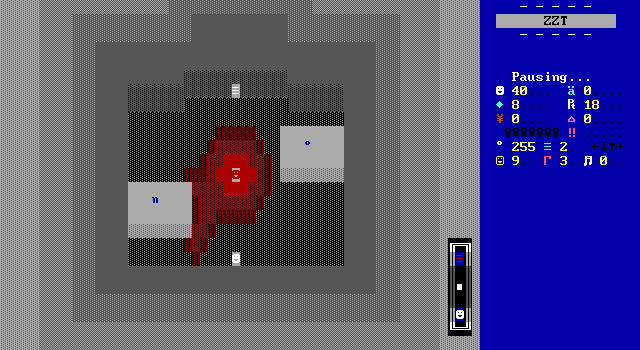
That's really all there is to the game. A short survival-horrorish inspired ZZT world that downplays the spooky scary atmosphere and leans in a bit more on the action and violence. It's pretty small, and plenty of what there is in the demo doesn't amount to much. A single digit number of enemies, a piano that hasn't been hooked up to any secret passages, a story that relies on the clichés of the genre, and I suppose some visually interesting backgrounds.
None of this is bad. What's here plays just fine. It might not have left me longing for the full game that never was, but I did enjoy the time I spent with it. I still have no idea how this got picked to be a Game of the Month winner, and at this point, the best I can come up with is that perhaps Stupid RPG did win, just in time for some community drama to have Knightt pull his games off the archive and a staff member deciding to retcon the award to Fabrication instead. I have zero evidence for this. It just sounds a lot more exciting than a very generic demo somehow coming out on top despite no real special qualities to give it an edge over several much more likely picks.
Gameplay That Only Exists In Your Head
Unless somebody fell for the hype?
Even that wouldn't be much of an explanation. Like any preview of an unfinished ZZT world, the author takes the time to let players know what they can look forward to in the full version. Fabrication does so both at the end of the demo as well as in the introduction, giving players plenty of things to be potentially excited about.

Here we have a perfectly no-frills ZZT world that's missing the pièce de résistance: its RPG engine! While promised in the opening scroll as an eventual feature, there's nothing to show of it yet.
The thing is, this is a demo from 1999, so merely promising RPG battles isn't going to be winning anyone over. By this time, the RPG engine had gone from a demonstration of mastery of ZZT-OOP, to an outright cliché, second only to Barney the dinosaur in terms of saturation. Unlike Barney, these engines provide an opportunity to do something unique regardless of how often authors managed to actually follow through. Bringing up RPG engines with no further details, not even so much as a mock-up of the interface, make me wary of what it might have entailed. I'd sooner expect such a thing to be included out of feelings of obligation rather than to make for a better play experience.
The only hint at any detail comes from the explanation of the bodycount engine where experience points are brought up, though not in the usual sense for action games where defeating enemies gives them out directly. Instead, breakout claims your kill count will be used to calculate how much experience you get from the RPG battles. That's something at least, but I'm still left in the dark about what experience points are used for. Granted, it wouldn't be the first time I've seen a level-up system didn't actually do anything.
Another yet to be delivered promise is for players to be able to find more powerful weapons. Obviously, "gun" is a reasonable contender there, though I'd prefer if the game stuck to its melee-only style as the combat in its current state is by far the most appealing aspect of the game. Giving the player a gun means the objects you shoot at have to react to all bullets that come their way, and as the skeleton enemy already makes it clear that ranged attacks for enemies are going to be included it would be easy to ruin things with friendly-fire as countless action games have before.
More melee weaponry however would be welcome. Depending on how and when weapons would be added, the game can change its tone a bit. Optional upgrades found quickly can keep the current tone of the game where the monsters are no match for Chris. Or maybe players would have a hard time coming across them, instead going more survival horror as enemies become more of a threat to an under-powered player. Do you fight them right away to increase your body count? Or do you hope you can return later to clean up BioTech's experiments with something mower powerful than a knife? Like perhaps, a big knife.
One more currently unimplemented feature could take things in a few directions as an inventory system is promised as well. Things could go full on Resident Evil here with weapons, healing items, and puzzle components taking up a limited inventory space. It's easy to come up with ideas. A fall-back knife to rely on plus an alternate weapon that could break after a certain point, or only be effective with certain foes. Perhaps a gun with ammo being rather limited. ZZT action games tended to keep it simple, but I feel like the genre has a lot of unexplored styles of gameplay that could work well.
But again, that's just me coming up with fun action game ideas in my head. What's shown in this demo doesn't really offer many hints into how the action was intended to develop. It plays things very safe here, resulting in a pretty forgettable little demo that thanks to an unusual decision back in 1999, has managed to keep itself the spotlight.
Final Thoughts
I did scour a few ZZT magazines from around this time hoping for a review to give some insight as to how the game was actually received. While Damage Inc. had their own magazine, the last issue is from roughly a year before Fabrication. None of the other magazines I checked mentioned the game either. An old z2 forum post brings it up in a list of recommendations for world to play along with a dozen more with no elaboration. The old Tripod-hosted Interactive Fantasies website has scores for the game provided by Hercules and Hydra. Unfortunately it was not one of the few games that were given full reviews, instead leaving us with two scores both in the low 80s. So I guess they must have liked it?
I really don't know what to make of this game's award-winning status. It feels mean to say it was the wrong call, and particularly petty given how long ago that decision was made. I'm just very very confused still. What we have here is a short demo with a few ideas that have some promise. Not much has actually been delivered. Nothing here ruins the experience. Perhaps full version of the game wouldn't have delivered, but this is the demo we're dealing with, and what's in the demo is perfectly average.
Aside from the Game of the Month award, there is nothing about the Fabrication demo that stands out in any meaningful way. I would not have taken notice of this one on my own anytime soon, and had it been streamed or played casually, I'd probably completely forget about it within an hour. There's nothing much here beyond a mystery, with not satisfying answer to be found. Whether somebody on zzt.org's staff needed to scrub Knightt from history, or got caught up in the promised features (who knows if the game was being promoted on forums and other ZZT websites of the era), or maybe they just really liked the game as is is, doesn't change my reception to it today. An action title with a touch of horror, that could be good, could be bad, but most likely be just one more such game for the pile.
- [1]Not always though! The earliest Game of the Month awards were just staff picks period. The community wanted an award for modern titles, and so the requirements were changed, and the Classic Game of the Month award was created to promote (usually) much older titles instead. This lead to the fun quirk of Burger Joint receiving both awards over the years.
- [2]Okay, other than the part where it turns out you can take that purple key and turn it in at the start of the game, skipping the rest of the northern branch of the dungeons entirely. Nobody knows they can get away with that on their first playthrough though, so my point still stands.

